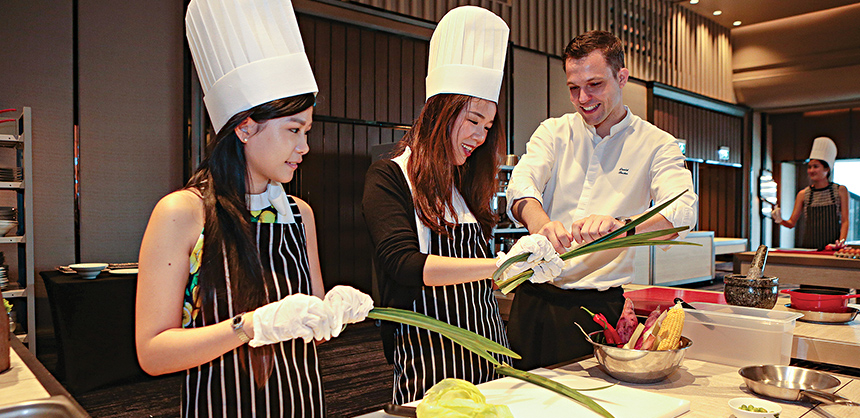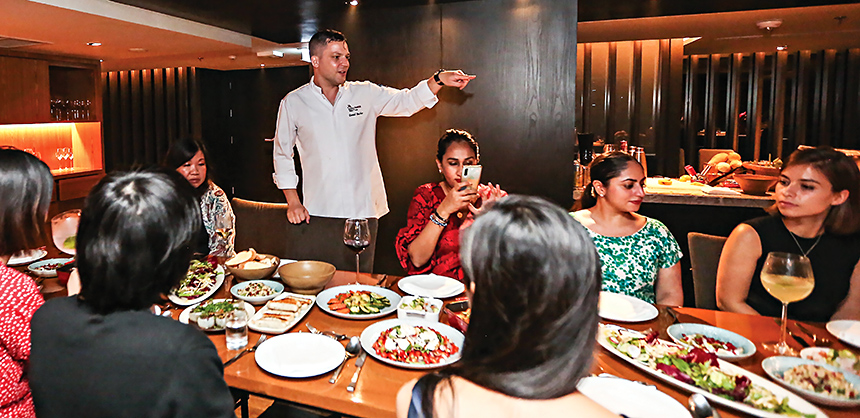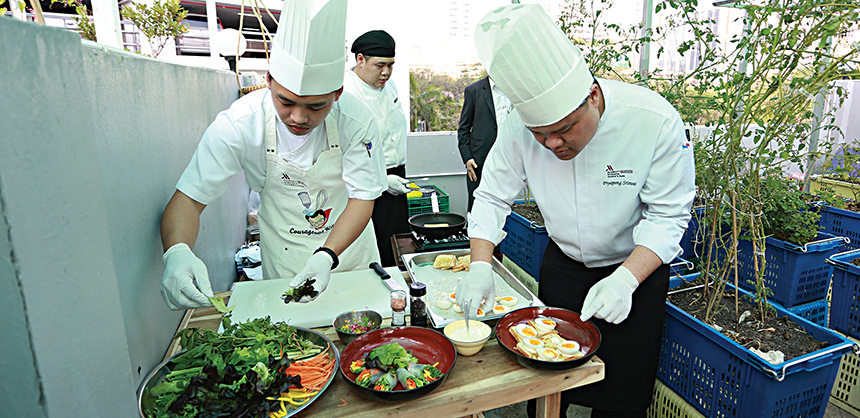Serve This, Not ThatSeptember 2, 2020
Everything You Need To Know About Smart Menu Planning By Nancy MuellerServe This, Not That
Everything You Need To Know About Smart Menu Planning
One very popular F&B trend is offering cooking classes or cooking demonstrations, which gives attendees a chance for a truly unforgettable experience at an event. Courtesy of Daniel Bucher
When it comes to smart menu planning for their next group event, meeting planners recognize that one of their top priorities is discovering how best to balance their food and beverage budget with participants’ palates and dietary needs. Additionally, as good stewards of the environment, conscientious planners are simultaneously looking for ways to reduce their event’s carbon “foodprint.”
If you are a meeting planner looking to achieve these goals, consider these best practices followed by executive chefs and sustainability experts:
Start with a Vision
Daniel Bucher, executive senior sous chef, oversees menu planning for Bangkok Marriott Marquis Queen’s Park in Thailand, where organizers host events in more than 30 meeting venues and three unique ballrooms, comprising approximately 50,000 sf of conference space overall.
Creativity and sustainability lie at the forefront of Bucher’s menu-planning models. While client conversations can begin with the meeting planner’s budget guidelines or the hotel’s standard menus, for Bucher, everything begins with the client’s vision. He says, “My favorite approach is when clients have a clear expectation of what experience they want to deliver. I will then fill this vision with flesh and bones and create an unforgettable experience. When we agree on what to do, I will then calculate how much it costs.”
Bucher says that the better he can understand the group profile, “The better I am able to offer exactly what is best matched for each individual group.” He starts by asking planners: “Who is attending? Male or female? Young or senior? Active sports team or computer programmers? What is the nationality? Religion? Are they well-traveled and global citizens, or is this the first trip overseas? What is the purpose of the event? Is it a hiring fair where people want to be on their best behavior or a company incentive that is all about celebrating?” His questions are based on more than mere curiosity. In fact, he explains, “All of these factors will hugely impact what and how much people eat.”
Make a Plan
Tracy Rose, executive chef at Coeur d’Alene Casino Resort Hotel, looks at smart menu planning through the lens of the “5 Ps: Proper Preparation Prevents a Poor Performance.” Rose explains, “We start planning and ordering food for our banquets at least a week early most of the time. So, last-minute accommodations can be challenging.”
Like Bucher, Mariela McIlwraith, CMP, CMM, MBA, vice president of Sustainability & Industry Advancement at the Events Industry Council, also stresses the importance of getting to know the food and beverage needs of event participants up front to help with smart menu planning. She says, “Asking participants which specific functions they’ll attend through the registration process or through the event app can help with forecasting. Event organizers can look to historical attendance, as well as indicators such as room block pickup patterns, to better anticipate attendance at meal functions.”
Once Bucher has a good understanding of the meeting planner’s vision, the purpose of the meeting and a profile of the meeting participants, then, he says, “It is a question of mindfulness and a thoughtful selection of menus and experiences. No matter how big or small the budget is, there is always the opportunity to ask yourself the question: What will have the biggest impact? What is unnecessary or will go unnoticed? Where is my budget spent best? What are the hidden costs in my selections for people and planet? How can I make sure my money lands at the right place and supports the right people? How can I grow and learn, and deliver an even better event than last time? None of these questions depend on how small or large your budget is.”
Starting from a baseline of tested recipes for specific numbers of people, “usually in increments of 50/100/150,” Bucher says, he and his culinary team purchase food and beverage quantities predicated on the number of expected participants which he can then modify depending on what he knows about the group. Working in tandem with the meeting planner, Bucher can adjust quantities based on what he discovers about the group’s eating behaviors, especially if the group is on-site for a few days. “On the first day, we will add a 10% to 15% safety net, while on the following days we might reduce this dramatically if we see an opportunity to do so. Nobody likes waste — chefs least of all. But if you have ever stood in front of hundreds of guests and ran out of food, you also know how important it is that we have enough food to offer.”

Daniel Bucher, executive senior sous chef at Bangkok Marriott Marquis Queen’s Park, relies on his client’s vision for menus.
Communicate
If having a vision, purpose and profile of event participants is where smart menu planning begins, the lack of having clear communication channels between the on-site culinary team and meeting organizers is where it ends. For McIlwraith, that means having clear communication regarding dietary needs. She says, “This requires collaboration between the event organizers, the caterer or food service provider and the event participants as well. Good communication channels need to be in place to ensure that goals are met.”
After a Marriott International survey of more than 2,000 participating meeting planners on event menus revealed that “45% of participating planners think it is important to talk to the chef prior to confirming a menu for the event,” Bucher set systems in place to create space for those conversations to happen. How? “We proactively offer food tastings,” Bucher says. “I encourage sales and event teams to facilitate direct conversations with the chef, and we tailor menus to fit clients’ needs.”
Bringing everyone on board, especially when communicating across cultures, presents its own set of challenges, however. When Bucher first sought to raise the bar on food reduction in Thailand, he hoped to have the hotel’s garbage collection company deliver data on what materials and quantities they picked up daily at the hotel. “My motivation was to better understand what we are actually throwing away. This information is vital in focusing on the right areas. I was also hoping we could start to do a better job at separating our garbage to simplify the pick up for the contractor. However, my initiative was thoroughly misunderstood and the contractor started to mistrust us. He was thinking that I wanted to know how much our garbage is worth in order to maybe generate additional revenue by selling some of it off to someone else. So they refused to give us any information on how much or what was picked up each night. When I continued to pressure, they just stopped picking up completely for days. The mountains of garbage were growing daily and we soon ran out of refrigerated holding space for the garbage,” he says.
Only after a lot of explanation and profuse apologies was Bucher able to persuade the supplier to come back to pick up all the garbage that had accumulated. “I learned from this that sustainability is not something you can achieve alone and by force. It is only when you help people understand and guide them with an emotional approach that you can truly make a difference.”
Feature Local, Seasonal Cuisine
At Coeur d’Alene Casino Resort Hotel, “Menu planning is designed around the seasons and availability of the products.” Rose says. “The model that I follow is watching what is trending. This allows us to have the trending menu items along with comfort menu items that guests keep coming back for.“
Matthew Brennan, formerly the executive chef at The Vinoy Renaissance St. Petersburg Resort & Golf Club, agrees. “Start with a sense of place,” Brennan advises when asked for tips on smart menu planning, “You have to use what’s local to your environment. Here in Florida, we focus on citrus, potatoes, strawberries, tomatoes, plantains and food items from Latin America.”
Brennan averaged about “12,000 to 15,000 steps a day” as the go-to guy for everything from making decisions about menus to teaching cooks how to enhance their culinary skills, to jumping on the line if busy, to checking in with any one of the 78 people who reported to him, including six chefs at the property.
Having a strong sense of place also means being smart about what produce and ingredients to use at what time of year. “A community menu is community-based,” Brennan explains. “You have to know where your produce is coming from to ensure that you and the vendors share the same food standards for quality.”
Bucher also touts the benefits of going local for quality produce for event menu planning. “The things I still get most excited about are some new local ingredients or seasonal fruit from our favorite local farms. At the moment, longan has come into season. It is a delicious Thai fruit that might remind you of lychee, only a lot more tasty.”
And when costs are a top consideration, as every meeting planner can attest, McIlwraith suggests, “Vegetarian options can help you stretch your budget and are likely better from a carbon and water footprint perspective as well.”
To discover what produce local vendors are most excited about from week-to-week, that is, what’s fresh and what’s new in their produce offerings, or what’s unexpected or a new food discovery, Brennan explains, “You have to have a great relationship with vendors.”
Bucher adds, “When talking about purchasing, relationships that go down the supply chain past mere suppliers are important. To understand the product I am working with, we contact and visit producers on a regular basis. We assess the producers we work with and build long-term relationships. These, in turn, enable us to work on a better quality product over a period of time. Here, also, the key is to limit the amount of products you are working with but increase the quantity of product you are buying. So instead of having to focus on hundreds of thousands of different products, you are able to dedicate more time to the products you are using and make them the best you can while also keeping their value. Food prices largely depend on quantities.”

Chefs say presentation is atop the list when working at an event. Also high on the list is using locally sourced food and vegetables, which is better to give attendees a taste of local cuisine. Courtesy of Daniel Bucher
Implement Sustainability Practices
Sustainability plays such a significant role in smart menu planning, McIlwraith says, “Because the choices that we make as event professionals are amplified due to the large number of meals that are selected based on our decisions. Implementing practices to prevent food waste can really help to control costs.” As leader of the Sustainability and Industry Insights Initiatives for the Events Industry Council, McIlwraith has been a passionate, award-winning advocate for best sustainability meeting practices.
Yet, sustainability can be viewed from several different perspectives. For example, Brennan describes how corporate sustainability fits into smart menu planning at Vinoy Renaissance: “We’ll use different fish on the menu depending on what we need to do to give fishing grounds time to recover.”
“Seed variety, food waste, plant based, vegan, local, organic, community based . . . all of these can be important elements of the menu you offer,” Bucher explains. “However, most important of all is to reduce selection and offer just what is needed. This is a big challenge most of the time as we have grown so used to associating luxury and richness of experience with variety. In fact, we couldn’t be more wrong. It is not choice and variety that makes food good. It is focus, attention and detail. It is quality of ingredients, care and time. One of the biggest problems in the industry is the fear that we won’t have enough.”
Bucher says,“Raised in a food environment that doesn’t know any better than living, cooking, preserving and eating with the seasons” like he did as a child, “you don’t realize how precious and perfect this relationship to our environment is.” It’s a childhood lesson he takes to heart, adding, “Sustainability for me is more than a nice thing to have. It is the basis for all my decisions, and, of course, for planning and structuring all menus we offer. It is equally as important as guest satisfaction, food safety and budgets. I truly believe in the reality of triple bottom lines and am most happy when we deliver events or menus that come out win-win-win.”
Get Creative and Keep Learning
Smart menu planning depends on creativity and innovation, Brennan says. “Keep in mind current dining trends, for example vegan weddings, to stay current and relevant; but, don’t be afraid to think outside the box,” he says. “You have to find inspiration in everything. If you can’t adapt, you’re done. You’re cooked, so to speak. Menu planning is something I’m always working on, when I go to the shore, out driving, take a fishing trip. I’m always pushing the bar to be as creative as possible. Different chefs run different outlets on our property, and they give their own spin and take on the menus. Never stop learning. Menu planning is constantly evolving, and I’m constantly learning. It’s like parenting.”
To enhance that learning and communication channels with meeting planners and event participants, Bucher says he has incorporated “a few themed breaks, sustainable cooking classes, awareness breaks and lunches which have become increasingly popular.” He says, “These can be used as edutainment breaks to create awareness for these important topics but also be fun and lively, and enrich the meeting or conference in general.”
At the end of the day, Bucher says, “The most important thing is to always make delicious food. Never forget that food is at the heart of it all. That’s absolutely key for me. When the food I serve is delicious, I am respected as a chef and gain trust with our guests. Other chefs trust my advice and ideas,” he says. “And guests are willing to divert from their usual eating habits when they feel there is something to gain — like a new exciting flavor or an eating experience that makes them happy. Of course, it is also a lot less likely that delicious food will be wasted.”
For Rose, that means making sure attendees are happy. He says, “Our job is to make sure that all of our guests enjoy their event and love the food served, so we go above and beyond trying to make sure that our guests get exactly what they are hoping for. Even if that means creating a menu specialized to their group.”
Brennan agrees, saying, “You always want to give to the max so customers are wowed by every meal,” a point on which meeting planners, culinary teams and event participants can wholeheartedly agree. | I&FMM |








